Text
Meet Care/of, revolutionizing and personalizing vitamins (and making them look real good, too).
We've all walked into a vitamin shop(pe?), looked around dazed, confused, and probably turned off by ugly bottles that all look the same. BYE to all of that. Care/of is the personalized vitamin experience of your wellness dreams. We chatted with the founders on vitamins.

Why vitamins? What inspired Care/of to get into this space?
We’ve all had that moment standing in the vitamin aisle, totally confused about what vitamins to take. And nobody in the drugstore really has the expertise to help you figure it out. Having had those experiences, our founders, Craig Elbert and Akash Shah, just knew there could be a better way to help customers find the supplements they need, using a combination of nutrition expertise, technology, and great design.
We set out to create a vitamins brand that offers helpful, honest guidance about how supplements can help you be healthier, in a friendly way.

What does Care/of hope to achieve with your brand and your customers, both in vitamins and beyond?
We want to make it easier (and more fun) for people to be healthier. People give incredible thought to their diets and health goals, and towards living a healthy lifestyle. We want to help them further their wellness goals by making it very easy to find the right supplements to take, and to make those vitamins and supplements a fun art of their daily routine.
What's the most common misconception about vitamins that people have?
Multivitamins are really common, but depending on your health goals and diet, they can really fall short in providing the nutrients you need because they’re made with an ‘average’ diet and person in mind. But each person is unique - with different diets (Vegan? Gluten free? Paleo?) and health goals, so it makes sense that your vitamins and supplements regimen would be unique too. By taking vitamins that truly complete your nutrition profile, you can do your body good and help with your health goals.
What makes Care/of different than the rest out there?
An important part of the experience is that we help you determine what supplements you need. We ask you a few questions about the most important elements of your health needs and recommend the right supplements based on guidance from our advisory board including doctors & researchers. Ultimately, we create a daily pack of vitamins created just for you - so it’s a personalized experience from start to end.
We are also intent on creating the best quality supplements - made with ingredients sourced from natural environments around the globe and made using clean practices. As an example our fish oil is sourced from Wild Alaskan salmon and our turmeric is farmed in India and other countries. We haven’t seen other vitamin brands invest in testing and quality the way we have, and they definitely are not transparent about their practices.
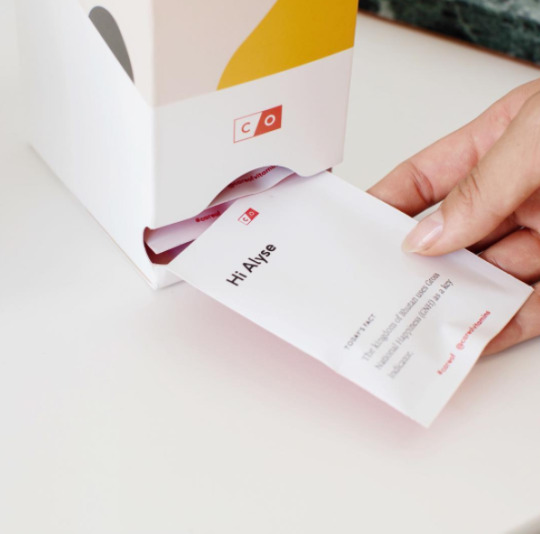
What's your favorite ingredient/vitamin and why?
It’s so hard to pick a favorite! But one that comes up a lot is Rhodiola. It’s an herbal supplement that helps support energy, and there’s some fascinating emerging research about it. Ours is sourced from the Altai Mountains in Russia.
What are the biggest vitamin deficiencies we have in winter/this season? And what can you do about them?
Vitamin D: In winter, it’s so common to not be getting enough vitamin D. If you live in the north or spend a lot of time indoors, it’s hard for your body to produce enough, especially in the winter. Taking vitamin D is an easy fix! Our vitamin D is the D3 form, which is the kind of vitamin D your body produces, and is fermented with whole foods so it’s easier on the body.
Fill in the blank. ________day
Have a healthy day. Too easy? :)
0 notes
Text
Maria Marlowe’s Top 5 #skinhappyfoods
We sat down with skin-focused nutritionist Maria Marlowe for a full interview. Here, she boils down the top five things on her grocery list for clear, healthy skin.

FLAX SEEDS
Flax seeds are loaded with anti-inflammatory omega-3, which can help bring down a blemish quickly, reduce redness, and speed the rate at which wounds heal.
HEMP SEEDS
They’re tiny, but hemp seeds contain a massive amount of protein, including the sulfur-bearing amino acids methionine, cysteine and cystine, which are used to build strong hair, nails, muscle and skin. They are also high in omega-3, an essential nutrient that can help bring down the redness and swelling of blemishes and help prevent the formation of lines.

DARK LEAFY GREENS
Dark leafy greens are nature’s multivitamin,
so it’s no surprise that they contain the very nutrients your skin needs. They are off-the-charts in Vitamin A, which is needed for blemish-free skin, and Vitamin C, which is needed for wrinkle-free skin. Greens are also a good source of sulfur, which plays a key role in a gorgeous, clear complexion.

RADISHES
Radishes contain a number of minerals and compounds that benefit the skin, including sulfur, silicon, and Vitamin C. These nutrients work together to create glowing skin by boosting collagen, strengthening the skin and stimulating the circulatory system.

MATCHA
Matcha has been found to help lower stress (a common trigger of breakouts) hormones in the body, and additionally provides a variety of powerful antioxidants which protect our health and slow down age-related decline, both physically and mentally.
2 notes
·
View notes
Text
Eating for your skin with nutritionist Maria Marlowe
We know that everything we put in and on our bodies has an effect on how it functions. We sat down with nutritionist Maria Marlowe to pick her brain on how to eat right, clear up your skin, and feel amazing while doing it.
Can you tell us a little bit about yourself and how you got started in nutrition?
I never grew up dreaming about a career in health or nutrition, but after realizing how deeply food impacts our health on so many levels, I now can’t imagine doing anything else. In a nutshell, I grew up on a standard American diet of processed foods and found myself struggling with a number of health problems, most notably acne and a weak immune system in which I was always getting sick. I was also 20 pounds heavier in high school than I am now. The acne bothered me the most, and I tried everything (dermatologists, over the counter creams, prescriptions, facials, etc.) to make it go away, to no avail. Eventually, I was tipped off by a college classmate that it may be my diet to blame. Willing to do anything at this point, I researched it more, changed my diet, and my skin cleared up. I was so in awe of the affect that food had on the skin that I fell down the nutrition rabbit hole and have never looked back.

What is your top tip for someone who is trying to eat healthier but is overwhelmed with all the “health food” options?
Listen to your body! One person’s food is another’s poison... so don’t just follow whatever the latest food fad is. If you have any minor health concerns, such as headaches, low energy, skin issues, or digestive issues, it is a good idea to keep a food diary to start drawing the connection between what you eat and how you look and feel. I also suggest working with a health coach or other wellness practitioner who can hold your hand and guide you through the process, cut through the confusion, and help you find the healthiest way of eating for you.
We crave comfort food in the winter time. What’s a cozy, “feel good” recipe that we can make at home?
For a winter comfort food recipe you can feel good about, try the Sweet Potato Mac & Cheese recipe on my website. Free of gluten and dairy. It’s a favorite!
What is one food people consider “healthy” that really isn’t doing us any favors?
Diet soda. It’s worse than regular (which isn’t good either, obviously!). A University of Texas study found that drinking two cans of diet soda a day increases your risk of obesity by 54.5% (compared to 32.8% for those who drink the same amount of regular soda). The paradox with diet food is that, generally, the more you drink or eat of it, the more weight you gain!
We’d love to hear more about your unique approach to helping treat acne through food.
There are many different possible causes of acne, with some of the most common being malnutrition, improper diet, poor digestion, hormones, stress, and pollution. You can have multiple causes, and they all feed into each other. For example, your diet has some influence over your hormones, or if your digestion is compromised, you may not be absorbing the nutrients you need, even if you are eating them. When someone comes to me with a history of acne that won’t go away, I assess their entire current diet and lifestyle to pinpoint the possible underlying causes, and then offer suggestions and recommendations for bringing the body back into balance to clear up the acne. These include adding or removing specific foods, as well as self-care practices, dealing with stress, and natural beauty product recommendations. In my EatBEAUTY guide, I help people be their own body detective, and give them the tools and road map to do this on their own.
What are some of your top tips for incorporating acne fighting foods into your diet?
1. Avoid sugar and highly processed foods. Numerous studies have shown that a high glycemic diet, one filled with large amounts of sugar and highly refined foods, such as bread and pasta, increases risk of acne.
2. Incorporate more fresh vegetables and fruit. These provide the nutrients and fiber our skin and digestive system need to look and work their best.
3. Drink Adequate water! Yes, we all know this, but how many of us actually drink enough?! Aim for at least 2.2 liters of water a day.
You can read more about Maria and reach her at her website mariamarlowe.com. Photo courtesy of Maria Marlowe.
1 note
·
View note
Text
Meet Hayden Slater, Founder of Pressed Juicery

You may have seen their neat little jewel box shops popping up everywhere, from just north of Houston in Soho on Lafayette to the recently redone Turnstyle in the Columbus Circle subway station. We sat down with the founder of our favorite juice brand to talk all things cold-pressed and more.
Why juice? What inspired you to get started?
Pressed Juicery was founded in 2010 as a passion project. I started Pressed with two of my childhood friends, Hedi Gores and Carly de Castro, because we felt that there was something missing in the market. We really loved the idea of not only making healthy alternatives accessible for all, but also doing it in a playful and fun way. We started Pressed in a 22 square foot broom closet in Brentwood. Every night from 10 PM to 4 AM, I would make juice, load up my car, and bring it to the kiosk in Brentwood, where Carly would work the first shift. That’s how it all began.

We wanted our friends, family and community to access a product that had influenced our lives so much. Juice was really a gateway, a catalyst that made us gravitate towards healthier decisions. Being in LA (often referred to the epicenter of health and wellness), we knew that this concept would do well, but we never anticipated that it would happen so quickly. Seven years later, we have over 55 locations with many more in the pipeline. Pressed Juicery has become a national leader of the cold-pressed juice movement.
We believe that we are so much more than a juice company—we’re a lifestyle. With product innovations like Freeze (our version of fro-yo made from 100% fruits, veggies and nuts) and Heat (our line of superfood lattes) and an online presence on PressedJuicery.com and TheChalkboardMag.com, Pressed Juicery is really seen as a way of life. We feel so fortunate to be in the position we’re in and a part of the conversation.

What do you hope to achieve with your brand and your customers that goes beyond the juice you serve?
Our mission is simple: to make high nutrition a realistic option for all people. As a company, we feel very strongly about community and providing a product that’s for everyone. To support that mission, all of our cold-pressed juices start at $6.50 and are made from raw inputs—the same fruits and vegetables that you would buy at your grocery store. We offer a variety of flavors so that there’s truly something for everyone at our stores, whether you are a novice or a seasoned juicer.
We want to show people how good they can feel when they make nutrient-rich products a part of their routines and lead by example to spark a larger conversation that delicious, affordable and nutritious don’t have to be mutually exclusive. As a whole, we are deeply committed to quality. Pressed is BRC audited—which is the highest global standard for food safety—and we’ve also assembled a medical advisory board. It was very important to us to have the stamp of approval from medical professionals.
What's the most common misconception about juice that people have? I think a big misconception about juicing is that is has to be extreme, that you have to change your entire lifestyle in order to feel the benefits. At Pressed, we’re very passionate that everyone is different and all of our customers have unique needs and goals, we truly have something for everyone. We believe that great tasting and healthy don’t have to exist separately of one another. We pride ourselves in making nutritious products that are delicious, affordable and fun. We are serious about health, but don’t take ourselves too seriously.
What makes Pressed Juicery different than the rest out there? We realize that we can’t be all things to all people, but it’s important to us to be the best at what we do. I also think our product extensions like Freeze and Heat truly set us apart. Additionally, we want to encourage our customers to be better, to incorporate nutrient-dense products into their routines and to take a step towards feeling their best. Personally, I have experienced amazing benefits from making juice a part of my day, and my goal is to share that feeling with others. To that end, rather than seeing other juice companies as competitors, we get excited about making noise with other companies that have similar missions to us, we really want to encourage like-minded businesses to make nutritious products more accessible and widely available for all people.

What's your favorite ingredient and why? Weirdly right now I’ve been really into parsley. I’ve never figured out whether it’s an herb, a spice or a vegetable, but it’s one of those foods that I just feel is loaded with antioxidants and has disease-preventing properties. I also feel like it always gives me good breath.
Juice aside, can we ask you a few personal questions? ...What do you want to be when you grow up? A storyteller
What do you do to take care of yourself? I make sure I laugh a lot, I’m into cryotherapy (might be a fad but I’m into it) and lately I’ve been loving float labs. I also make sure that I dedicate a good amount of my week to being outside whether hiking or just walking around Venice.
You guys are quickly moving into New York from your LA roots. What do you have in LA that we don't that you wish you could bring with? (We're getting a Gjelina, so there's that...) Well to start, the weather wouldn’t be bad. It would be nice to see some of the health and wellness we have in LA make its way to New York a bit quicker. Things like cryotherapy, float labs, oxygen chambers and infrared saunas. On the flip side, it wouldn’t be bad to get a Heyday out here.
Fill in the blank. ________day Do your best everyday.
Photo of Hayden by Justin Coit.
0 notes
Text
Happiness hacks for the city dweller’s indoor season
Some of our favorite ways to feel warmth in winter.
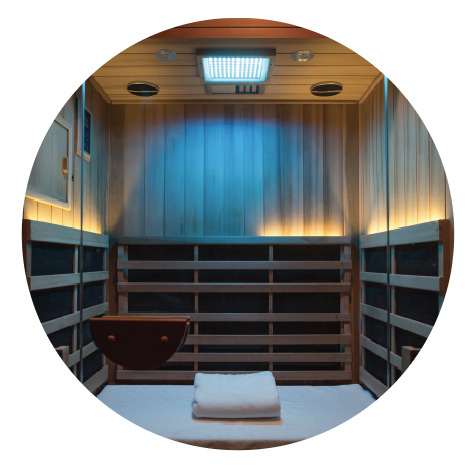
Warm up inside an infrared sauna. We’re addicted to the heat of the infrared saunas at HIGHERDOSE. Not only is it great for your skin (hello, Light Therapy), it’s also proven to reduce muscle and joint pains. When its 12ºF out, all we want to do is put on our most low-key Spotify playlist, zone out, and detox away our morning’s chilly commute. higherdose.com
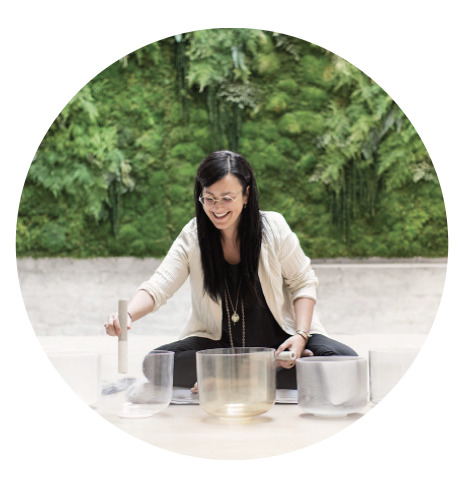
Meditate, breathe deeply, and try a sound bath. We take an hour each month to meditate as a team in the shop, thanks a visit from MNDFL. Take a mental break and start a practice at this beautiful and un-intimidating studio, which now has three locations, in Greenwich Village, the Upper East Side, and Williamsburg. mndflmeditation.com
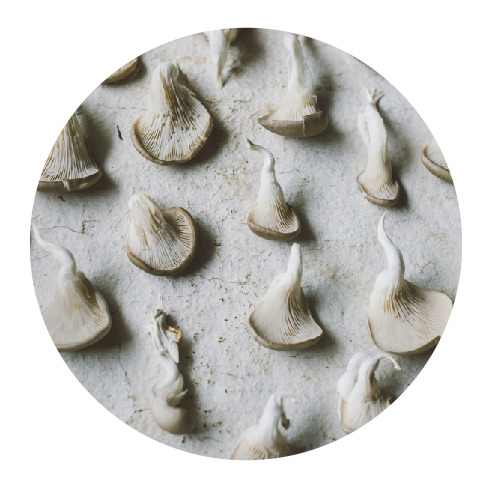
Do ’shrooms. We’re all about increasing our happiness and wellness naturally, especially when it’s super bleak outside. We recently got turned on to FOUR SIGMATIC Mushrooms, a company that incorporates body-and-mind balancing mushrooms into familiar recipes (think hot cocoa, coffee, and delicious smoothies). foursigmatic.com
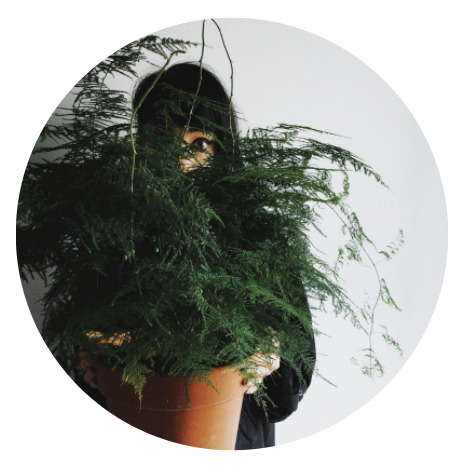
Fill your space with greenery. Beat SAD this winter and sit by a window with a perky new plant from our friends at The Sill in Chinatown. Have a black thumb and afraid of committing planticide? The experts there can guide you on the best easy-to-care for plant for your space. thesill.com
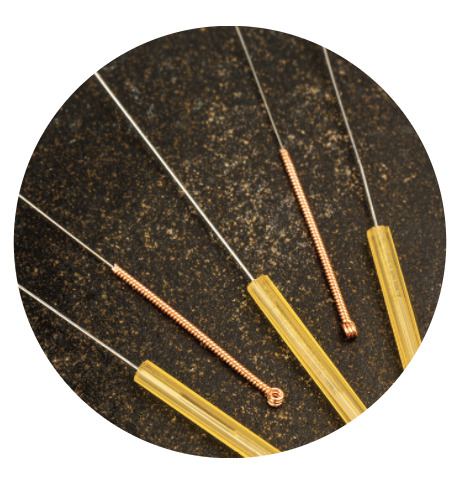
Try acupuncture. Heyday member and GOTHAM WELLNESS founder Stefanie DiLibero has been coaching the team here at Heyday for months now on at-home self-care with ball and foam rolling. She’s also opened our eyes (and chakras!) to the ultra healing properties of acupuncture, which may be the perfect Saturday activity to chill you out and release built up stress. gothamwellness.com

Let your senses literally float away. Escape the bitter cold air by stopping into LIFT FLOATS in Carroll Gardens. The sensory deprivation tanks feature body temperature Epsom salt water to help you relax, ease muscle tension, fatigue & relief from high blood pressure. Float in utter silence, or choose the soothing music. liftfloats.com
8 notes
·
View notes
Text
In a wellness world, what exactly is self-care and how do you do it?
By Jeni Sykes, Head of Skincare & Co-Founder

We all want to put our best face forward.
It shows in our Instagram filtering prowess, in the cleverly crafted posts we share to project identity and document a life well-lived. Our platforms provide both an open stage to tell our stories and powerful – even addictive – evidence of approval and acceptance through the views and likes we’ve come to count.
We want to be seen, and we want the world we’re plugged into, both on and offline, to like what they see. We also know that this desire is nothing new. And the deeply human need to be seen and to feel accepted doesn’t automatically make us shallow.
In fact, resources like Gallup, Forbes, Fast Company, and the myriad others seeking to illuminate exactly what motivates us today also report two notable and noble aspirations shared by Baby Boomers, Gen-Xers, and Millennials alike – the ability to have a positive impact on the people, organizations, and communities around us, and the ability to experience a sense of well-being in our lives.
Yet there is also sense of inner conflict on the rise, in spite of our most positive intentions and shared dreams of purpose, passion, and wellness: Increasingly, we struggle to tap into that panacea of passion, to cultivate the deep and satisfying human relationships we envision, and to find genuine self-confidence and satisfaction in our personal and professional achievements.
It’s here at the impasse between desire and sense of deficit that we find certain buzzwords floating across our feeds as antidote. One darling of the day: self-care. But what does this word really mean?
We hear that self-care works to manifest this unicorn, Wellness, in our lives. We hear that self-care is about self-love, which is different than selfishness – an important distinction in an age where the words narcissism and entitlement are also frequent fliers. We hear that self-care is about making healthy choices. One should eat well, exercise, get a massage, hit this new class or service, read that book or blog, put the phone down, learn to meditate, get a handle on the right routine, and get ready for a Transformation.
But what if we embark on this journey to find that like our quest for purpose and impact, our honest attempts at self-care don’t always seem to be so successful or so profoundly rewarding as the others’ compelling snapshots of Wellness seem to portray? Basic questions come up. Like, am I doing this right?
Over the holidays I received a book from a friend, The Empathy Exams, and in it, my friend wrote a simple inscription that struck me. It said, “This book is about how we feel, not what we ought to feel. And that is an accomplishment.”

In a rapidly updated, overstimulating world where we stay carefully coiffed in order to avoid the pain or failure we fear under the seemingly constant gaze of others, we can also end up overwrought with judgments for ourselves. Often, we’re simply mirroring the judgments others have placed on us over time. But learning to engage in self-care also means learning to slow down enough to connect to ourselves in a different way.
If we only check off boxes on a to-do list of things that are supposed to make us happier human beings, it’s very possible to go through the motions and still end up feeling just as exhausted or overspent as we started.
Engaging in self-care can powerful. Habits can show us how to give to (not just of) ourselves and that receiving is part of what replenishes us as people.
Engaging in self-care can be challenging, too. It often takes learning a much healthier dose of patience with where we’re at today than we’ve grown accustomed to allowing, and showing ourselves a kindness we may not have been shown by the world. It takes letting go of some of the judgments, worries, and guilt in the small acts offstage. Regardless of the rituals you choose, it’s choosing to show up for ourselves this way that actually cultivates that evasive thing called self-love. And as mothers, shrinks, and gurus so love to tell us, that brand of loving relationship with one’s self is ultimately what leads to deep and meaningful relationships with others.
How does this connect to skincare? When you practice skincare as self-care, you can learn connect to yourself by learning listen to your skin, taking less time to judge it, and more time to understand its needs and turn toward it with care. You might have to ask for help. You might have to practice a little patience. For the long-term rewards, you do have to invest at least a little bit each day. With skin, cultivating caring habits that are right for you is what becomes magic in the mirror without a filter. And connecting differently to something as simple as your skin can teach you a whole lot about your whole self.
As one of our clients puts it in one of the most poignant emails we’ve received, “I love your brand and everything you all stand for – and you’ve made a difference in my life in a very meaningful way. Taking the small step of adding a facial to my regular routine has been a way to increase my awareness of the other things in my life I need to tend to myself
– nutrition, physical activity, and most important of all, self love.”
Putting your best face forward can be something profound. This year, may your journey be long, and so deeply rewarding.
2 notes
·
View notes
Text
Four things to keep your skin happily hydrated this winter
‘Tis this season for deranged radiators and sudden cravings for hand cream. Here’s four of our favorite tips to keep your skin happily hydrated through the rest of winter.

Get a humidifier, stat. A total game changer when it comes to cranky, dry, winter skin. Most of us in New York don’t have control over the heat in our apartments. One of the best ways to combat moisture-slaying steam heat? A cool mist humidifier. Use one of those increasingly rare Bed Bath & Beyond 20% off coupons on one that suits your style (we won’t judge if you get the frog-shaped one.) Super bonus points for this USB-powered desktop humidifier from minimalist shop Leibal at Canal Street Market. (Also, check out Canal Street Market.)

Take shorter hot showers. As the temperatures get colder, hot showers feel totally luxurious. But the steam can dry out your skin. Nobody likes a lukewarm shower, so we’ll just recommend keeping the hot showers as short as possible. Downer, we know, especially if your bathroom looks like that. (Sadly, ours does not.)

Put hand cream by the door. Place your favorite hand cream by your front door. Use some before heading out to keep your paws from getting chapped. It’s a great ritual to start the day. Two of our favorites are the unscented, clean, and hardworking Buckler’s Chapped Skin Remedy for $19 and the luxurious and on-the-go-bag-sized Grown Alchemist Vanilla & Orange Peel Hand Cream for $15.

Incorporate a body exfoliant. Can’t shake that dry skin feeling under your wool sweater? Try exfoliating your body in the shower, something we often over look. Since we took away your longer hot shower just above, add a little something back into the experience. It’ll help your body lotion absorb better in these drier months. The Grown Alchemist Pearl, Peppermint & Ylang Ylang Body Exfoliant for $34 makes any shower look better.
0 notes
Text
Meet Melani, Skin Therapist

Why did you get into skincare? From the age of 12, I’ve been obsessed with skin. Being born and raised in a tropical climate, I always knew that having a healthy skin ritual was very important to keep your skin looking young and vibrant.
What do you want every client to leave with? Helping clients understand their own skin and how to build their home care routine to be able to maximize their best skin.
What do you do to personally take care of yourself? I have nightly rituals. It depends on what my skin needs at the time. But it usually involves a Guasha tool. Four years ago, I bought a small desk and seat for my bedroom where I sat every night and gave myself a treatment with intention. I think that its very important to have a intention when it comes to your skincare.
If you could share one bit of advice to our clients, what would it be? Understanding basic ingredients on labels is super important. Incredibly toxic ingredients can cause lots of damage to the skin. I usually try to empower my clients by providing basic information. And also drink more water!
Favorite Color? White. It always looks elegant and luxurious.
Describe yourself in just one sentence. Oh geez, this is a hard one. I would say I'm very intuitive.
What’s your favorite activity when you’re not at Heyday? There's a few things... taking a walk with my son and dog. Yoga and seeing my friends.
What were you in your past life, and what will you be in your next life? In my past life, I was a warrior, queen of a tribe. In my next life, I'm not sure to be honest. At least i have a lifetime to decide....
0 notes
Text
Understanding Oil & Water in your skin
History is full of inseparable pairs. Peanut Butter & Jelly. Bert & Ernie. Hall & Oates. Thelma & Louise. Chips & Salsa. Without one another, it’s just not quite the same.
For your skin, it's oil and water. One you make, one you can't. Getting the balance right is the key to keeping the dry and blotch at bay this season.

All skin needs Oil Moisture and Water Moisture to function properly and do everything from looking and feeling great today to combating premature aging tomorrow. Depleted or imbalanced hydration – lacking either oil or water – is the first thing that causes our skin to go dull and rapidly accelerates aging (those fine lines…).
Skin that’s missing or being robbed of the moisture it needs - whether by environmental factors like pollution, heating systems, frequent travel, or simply the wrong skincare routine for the season – actually weakens and sensitizes the skin. Simply put, it puts the skin in a cranky state that doesn’t react well to much. It becomes defenseless to heal and protect itself from damage, and those common skin concerns like rough texture, redness, overly dry and oily patches of skin, and even acne start to rear their heads. And harsh cleaners, over-exfoliation, neglect, the wrong products, or the myriad of things we tend to do when we panic about it doesn’t help the cause.
So what do you need to know about water vs. oil in your skin to stay feeling good this winter? Allow us to break it down in two paragraphs (for each, ha).
Water vs. Oil
Water. When your skin lacks it, it’s dehydrated. We’re made of, what, 70% water? But our skin actually does not produce moisture of the water variety on its own – it only receives it from water put into our bodies and water-based moisturizers put onto our skin. Like all things in life, the younger you are, the easier it is (heh) – to hold onto water moisture, in this case. In winter, things like deranged radiators controlled by your building, dry air, travel, hot-cold-hot-cold changes, dehydrate your skin.
What happens when the skin is dehydrated? It makes up for it by creating the only moisture it knows how to create – oil moisture (next paragraph, hold your horses). So now we’re dry, but we’re oily. We fight the oil by overdoing this or overdoing that, but we’re really dry…
Oil. When your skin lacks it, it’s dry. Skin produces oil naturally and needs oil moisture for strength, elasticity, and to function properly. This is where skin type comes in – Dry skin types makes the least amount of oil naturally, Normal produces about average, and Oily, well, you get it. Just like water moisture, as we age, the skin produces less oil, and at certain times of the year like winter, oil production slows (we imagine little oil production creatures feeling 😑 like we do on a 20º weekend day). Some habits, like cleansing with too much of a harsh cleanser, over-exfoliating, or using too many products marketed for acne can strip necessary oil, too.
What happens when the skin lacks oil? It becomes sensitized, or more simply put, a little pissed off. And in that state, breakouts, irritation, blotchiness, all kinds of things can happen. Over time, a lack of natural oil can compromise your skin’s natural barrier to defend against further water hydration loss. Sensing the cycle here?
What You Can Do
The best thing to do is to take a look at your routine and make sure you’ve adjusted it to compensate for a drier winter. Talk to us about your routine or to find out what ingredients are right for your skin type.
On the water front, ensure your cleanser is a gentle and hydrating one. Add a hydrating serum and/or richer moisturizer into your routine. And you might want to moisturizer in morning and night (keep up the combo SPF/moisturizer, but you might need some additional help at both ends of the day.) Use a hydrating mask once or twice a week for an extra boost. You’ll feel the difference.
On the oil front, just a few drops of a facial oil suited for your skin type can help you get the edge on dry skin, stay ahead of dehydration, and keep skin calm. “I’m already oily, how can I use an oil?” you might ask. Some adaptogenic oils even help to balance overproduction of oil. A little goes a long way, so a bottle can last you quite a while.
* * *
It may feel like we’re mincing words here between dry and dehydrated, since the end result can read similarly. But, it’s important to understand the difference to unlock your own unique balance of water and oil needed to keep your skin happy, healthy, and glowing through the duller months of the year.
3 notes
·
View notes
Text
Talking hospitality with two hosts with the most
When we sat down to chat with Patrick Janelle and Amy Virginia Buchanan, creators of Spring Street Social Society, we realized what we had in common was a passion for great hospitality. It’s something we talk about at Heyday perhaps as much as exfoliants and extractions.

The generic definition of hospitality is ‘the relationship between a guest and a host.’ To us, it’s about people interacting with people. It’s about making people feel genuinely welcomed and cared for in a new setting. It’s about choreographing and managing someone’s first experience with something. It’s the difference between nice and kind. And as hospitality king, Danny Meyer, of Gramercy Park and Shake Shack fame, so eloquently put it in his book Setting The Table:
“Hospitality exists when you believe that the other person is on your side. The converse is just as true. Hospitality is present when something happens for you. It is absent when something happens to you. Those two simple prepositions – for and to – express it all.”
So, tell us a little about the Spring Street Social Society. What is it and what did you set out to achieve with it? Presently, we are a social club with a membership of 350 members. As we do not have a physical home, we meet regularly, once to twice a month, a curated series of gatherings ranging from cabarets to coursed dinners, speakeasies to salons, and even occasionally taking over a bar or a restaurant. This is not what we set out to do, however. Spring Street Social Society began as a one-time-only NoLita backyard cabaret that received such positive response that we decided to continue putting on shows. The growth has been completely fluid and organic over the past four years, taking on whatever opportunities came our way, fit within our mission, and matched our integrity.
Sounds like you tap a lot of talents to put things together. Who do you collaborate with? An incredible team of artists. We work with calligraphers, chefs, storytellers, musicians, florists, stylists, installation artists, mixologists, sommeliers, dancers, clowns, jugglers, graphic designers, illustrators, and many more. Each event is unique and requires a different team of collaborators. The most exciting part is discovering what’s in store as it develops.
We’re always fascinated by our Heyday members and their stories. Who are your members? They’re the most wonderful spectrum of people from across New York, Los Angeles, and beyond. As we, along with our membership advisory board, comb through the applications, our first question we ask ourselves is “Would I like to sit next to this person for a 2 to 3 hour long dinner?” Members are curious, eager, and adventurous, considering that no one knows what the event (each of which is set in a secret location, revealed the morning of the gathering) will entail until it unfolds. Members are chic and funny, interesting and interested. Most of all, they have a lot to bring to the table, whether it’s their career (tech, finance, editorial, design, media, etc), or one of their many passions.
We talked about hospitality earlier. How do you define it? Creating an environment in which everyone feels welcome, both immediately and throughout the entire experience. Attention to detail, but also an insistence on all elements being well-curated, thoughtful, and serving a purpose for the enhancement of the event.

You’re in the business of making people feel comfortable in unfamiliar spaces. What’s your key to doing that? A major piece is choosing spaces that on their own feel inspirational, which make guests feel special for even getting to enter. We don’t do too much to mask imperfections, but instead work to enhance the character of the space and building upon the magic that’s already there. For example, maybe it’s an raw retail space inside of Penn Station that we have filled with 25 tons of sand, along with palms and twinkling lights. When you enter, you get a drink and a pair of Soludos espadrilles to maneuver the beachy terrain. That way, the wires hanging from the ceiling and the papered windows don’t bother you so much. Instead they become part of the experience. The feeling of hacking a city.
What’s your most memorably positive hospitality experience? What was so stand-out about it? Amy: Just recently. My mother was in town, so I took her to Untitled, the restaurant at the Whitney. I had emailed earlier to request a table. My mom wanted to take me somewhere special for my birthday, so they knew those things. 1) Mom’s in town from Fargo and 2) We’ve got a birthday on our hands. As soon as we were sat, the general manager showed up with champagne, and I said, “Oh, my mom doesn’t drink.” After that, a beautiful mocktail spritzer showed up, and two more after that. She kept going on and on about how wonderful the service was. How attentive. And I find that to be true of any Danny Meyer restaurant. They pay attention to the individual needs of a table and do their best to accommodate.
Patrick: A couple years ago, during a visit to Istanbul, I was staying at the Edition Hotel. Each day I would return, and all of my things were moved across the room and put away in places were far from where I left them. It may seem counter intuitive, but I loved it. Instead of the housekeeper merely tidying up and leaving things where they were, he was actually creating order out of my things. I never even spoke to him, and yet he was working hard to group my things together, put my life together in a way that made sense, as if he knew me, instead of just cleaning up and leaving.
What are the top 3 things you always have on hand to host in a pinch? A well stocked liquor cabinet and wine rack, a great playlist or record collection, and something to nibble on. Amy’s go to nibble is chips and salsa.
Okay, last one. Help us out – you’re both people about town. What are your go-to picks around New York for (1) a group dinner, (2) a cozy cocktail, and (3) some self-care? Saxon + Parole for dinner, where we love their bottled champagne negroni. A cold weather cozy cocktail at Sel Rrose in Manhattan and Donna in Brooklyn. And for self-care, Spoke & Weal, our favorite hair salon. Hospitality is just as important as a great cut.
0 notes
Text
A four-step guide to a post-flight glow
We're coming upon the busiest travel time of the year and we all know the recycled air inside the plane is notorious for zapping the life out of our skin.

While we can't help you with the slow Wi-Fi, we can help keep your face glowing when you land to your family and friends.
1. EXFOLIATE TO PREP FOR MAXIMUM HYDRATION
Before you head to the airport, cleanse and use a gentle exfoliant to ensure the next few hydration steps fully absorb into your skin.
2. SUPER HYDRATE WITH YOUR SKIN WITH A SERUM
Use a serum that contains hydrating superstar hyaluronic acid, a naturally-occurring ingredient in our skin that holds 1,000 times its weight in water. The TSA will never know you're sneaking that much liquid into your pores.
3. APPLY A MASK (AND LEAVE IT ON)
Next, apply a very thin layer of a hydrating mask (one whose directions allow it to be left on overnight). By very thin, we mean no one else should know you have a mask on. Remember to always put on your own mask before helping others.
4. FINISH WITH AN SPF
Put on your daily SPF (especially important if your window seat-mate doesn't close that shade) and use your hydrating mask the evening you arrive at your destination.
*BONUS STEP*
Pack a hydrating mist in your carry-on bag and spritz a few times throughout the flight. Yes, you'll be that person, but you'll be the freshest thing in coach.
1 note
·
View note
Text
Think of your skincare routine like a wardrobe: Adjust it seasonally
‘Tis the season of perhaps the biggest environmental changes for us and our skin here in New York. As the leaves fall, the little shifts in the air temperature (inside and outside), our schedules, our diets, and our holiday travel can add up to a big affect on our skin.

We recommend doing a few things differently to maintain great skin through the colder and drier months.
“Think of your skincare routine like a wardrobe,” says one of our Skin Therapists. “If you wear shorts in winter, your body may not be too happy about it. It should get tweaked throughout the year.”
Just as we wouldn’t with our closets, we don’t get rid of everything. We’re not here to blow up your bathroom cabinet (or wallet) with new products. Firstly, that’s too expensive, and secondly, our skin craves consistency. We’re about making small, smart tweaks to avoid the dry, flaky skin, surprise breakouts, tightness, or less-than-glowing skin that can come with the chillier days in the months ahead.
5 CHANGES TO YOUR ROUTINE The steps in our routines may be the same (cleanse, treat, hydrate, repair), but here are five changes we can layer in to keep our skin happy and hydrated:
1. Switch to a creamier cleanser. Cream cleaners remove dirt and makeup, but strip less oil from the skin, which helps keep us more hydrated.
2. Add an exfoliating step into your routine. If you don’t already exfoliate weekly, this is a great time to build this step into your routine. Your skin is able to absorb moisturizers more effectively when the surface layer of dead skin cells is gently removed. (An added bonus is that regular exfoliation helps give you that post-summer glow that we often lose as we spend less time outside.)
3. Try a more nourishing moisturizer. Richer moisturizers can provide your skin more hydration in the drier months of the year. You don’t have to toss aside whatever moisturizer you love and works for you, though. Try integrating something richer just at night when your skin is repairing.
4. Don’t forget the sunscreen. Keep using your mineral-based sunscreen during the winter days. The days may be shorter, but the low sun still gives off the same aging UVA rays as it does in the months when we’ve got sand in our shoes.
5. Take care of the rest of your body. ‘Tis the season when head, shoulders, knees and toes (and hands, and elbows…) need a little love. Keep hand and body moisturizers around to keep the rest of your skin feeling smooth and hydrated.
0 notes
Text
So what is Light Therapy?
In addition to blasting people to the moon, NASA and its research labs have given us countless other inventions we now use in our everyday lives, like Velcro, memory foam, portable handheld vacuums and more.
Add LED light therapy to the list. Originally used in medical applications to help heal soft tissue, the power of light-emitting diodes (LED) is now used in skincare treatments to stimulate the deeper layers of our skin.

Not as scary as this might appear. Light Therapy is non-invasive and feels like a nice warm light on your skin. Chances are good you’ll fall asleep while we do it.
So, shining a light on my skin helps with something?
In short, yes. The idea is that the light penetrates, in a non-invasive way, through the epidermis (your skin’s outermost layer) to the dermis (the layer just below). There, it stimulates the cells that are responsible for producing collagen and elastin, responsible for our skin’s plumpy-ness and ability to hold shape after movement. To go a step further scientifically, the light excites the mitochondrion in our skin cells (we know you at least recognize that from bio class) , causing them to produce more cellular fuel, thus, speeding up the process of collagen and elastin production, which, over time, can push up wrinkles and fine lines.
Red versus blue. What’s the difference?
At Heyday, we use both LED light therapy of the red light and blue light variety. The differences?
Red Red light helps in aging defense and repair of sun damage we’ve accumulated over the years. It helps your skin form new capillaries, which speed up the healing process by bringing increased oxygen to the area. At the same time, it stimulates the collagen and elastin production we mentioned above that helps with the appearance of fine lines and wrinkles. In the short term, it gives an awesome, plumping glow (we make sure anyone seeing us within a week of their wedding gets this!). And over multiple treatments, you can actually see a longer-term lift in those creases in the face.
Blue The blue light variety helps detoxify skin and can treat mild to moderate acne. How? It kills bacteria under the surface of the skin and calms inflammation. The heat from the infrared light can also help manage the activity of oil glands. Overall, the result is less bacteria and oil, which can be a huge help in controlling breakouts.

A Light Therapy inspired art installation, perhaps?
How does it feel?
As the recipient, all you feel is the warmth of a light near your skin. Chances are good you’ll doze off while we perform the therapy.
It’s safe for clients who are pregnant or breastfeeding. We love it because it’s non-invasive and merely amplifies your body’s natural healing process. The results are visible in the short-term and awesome in the long-term.
How can I try it?
Light Therapy is one of our treatment Enhancements ($35). As with all of our Enhancements, you can always add it the day of your treatment after chatting with your Skin Therapist about it. If you know you’d like it ahead of time, you can mark it in the Notes when you book a facial.
Love and light, The Heyday Team
0 notes
Text
Unmasking masks
What do they do? How do masks benefit the skin.
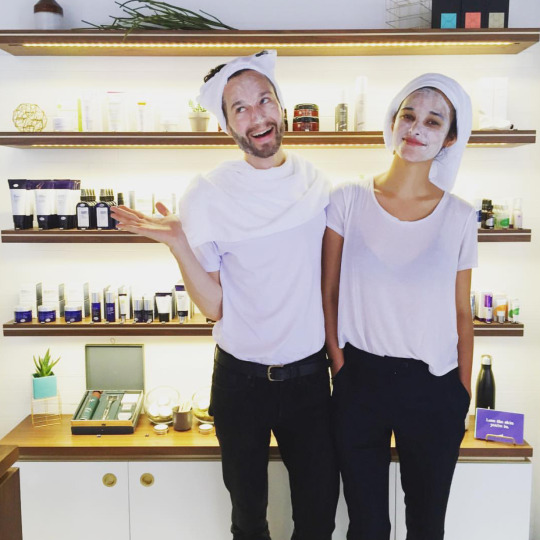
When it comes to the products you choose for your skincare routine, daily essentials like cleanser, moisturizer, and sun protection should keep your true skin type in its healthiest base state. Other fun products like serums and masks help you target specific concerns like evening out skin tone or texture, drawing impurities out of your pores, or replenishing your skin’s hydration and nutrients.
A great mask can deliver results after just one use and using the right mask or combination of masks as a consistent part of your routine can help take you to the next level achieving your skin goals.
A weekly masking ritual can be pure fun, or an essential part of your skincare routine, especially if high pollution, stress, regular travel or exercise are part of your life. Anyone can find masking particularly beneficial at season’s change as well, as these power tools can help skin transition gracefully from warm to cool weather or vice versa.
Where to start?
The two basic masks that every city dweller should have in the medicine cabinet are one that replenishes hydration, calms, soothes, and feeds the skin nutrients, and one that helps to detoxify the skin and pull impurities out of the pores. Hydrating, soothing masks don’t dry on the skin, purifying masks generally do, so the balance is important.
Hydrating masks are often overlooked as a critical tool for oily and acneic skin types. Well hydrated skin actually produces less oil and hydration is half the battle to beating breakouts. A hydrating mask is a great way to give your skin a deep drink of the calming moisture it needs to get clear without weighing it down or clogging pores with too heavy of a daily moisturizer. Start keeping a sample-size of one in your travel toiletry bag.
Skin Therapist Favorite: Alchimie Forever Kantic Brightening Moisture Mask. An antioxidant rich, blueberry-based mask that leaves the skin plump and glowing. Great after a flight (or, even apply a little like a moisturizer before boarding) or a long week.
Purifying masks generally feature clays or charcoal, which draw excess oil and impurities out of the skin. It’s important to be mindful when you reach for a clay or charcoal mask, because a purifying mask can also pull vital moisture out of skin that’s already struggling with dehydration. If your skin is depleted or very dehydrated, you can see irritation or even breakouts from this type of mask. These masks also work best on well-hydrated skin.
Skin Therapist Favorite: Shaffali Volcanic Ash & Sage Earth Mask. Draws out excess oils and other impurities. Feels like putting the best of earth’s natural goodies on your skin.
How often and when
Masking is best as a weekly ritual, but depending on your skin and the specific mask, some can be used multiple times a week. Your Skin Therapist can help you navigate which mask/s to start or what mask ritual is best for your skin this season, and how often to use.
When masking, start with cleansed, gently exfoliated skin. You want to remove dead cells built up on the surface of the skin so that your mask is able to penetrate the skin properly and deliver results.
How to fit a masking ritual into your routine
Decide on a time: Like any new habit you want to conquer, it’s important to put it onto your schedule. The easiest way is to choose a day of the week. Think about when you usually try to take a little downtime in the week or tend to be home. Will a mask be part of your Sunday morning milling around the house? Can it be a self-care skin and mood boost on Wednesday nights, when you’re halfway through your week and don’t usually go out?
Multitask: What to do while your mask is on? Anything! Just set a timer to make sure you don’t leave it in longer than directed, and do you about your business just as you would normally. You can mask while you clean, while you watch a favorite show. If you’re like many New Yorkers, you can put on a mask to give to yourself while you give your employer that extra hour of work from home. ;-)
Share. It’s fun! Masking can be part of a hangout. It’s pretty hard not to try a mask with friends and not come away with a good selfie…
0 notes
Text
Nailing down eight no’s when it comes to your manicure
Is a natural manicure a thing? What’s good and safe? Our Tribeca neighbors and spring pop-up partners tenoverten gave us the scoop.
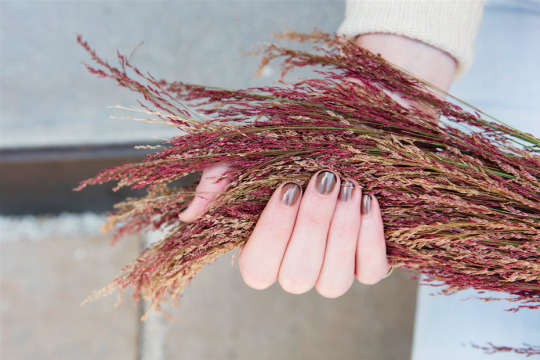
By the tenoverten team
While of course we love a shiny new manicure, we really care that what’s underneath is strong and healthy. To that end, we’re committed to making products that are as non-toxic as possible without sacrificing performance and quality. Just as we don’t offer acrylic or gel services at our salons, we want our customers to feel confident that the nail products they use at home are as safe as possible.
As of now, there is no such thing as an all natural when using nail polish. Any such claims are falsely made. Don’t lose hope though: tenoverten is at the forefront of stripping out as many toxins as possible from our nail polish. We hope that this serves as a guide to educate you in making the safest and least toxic choices in the nail polish/care category.
You might be familiar with 3-Free polishes (no formaldehyde, no dibutyl phthalate and no toluene), but tenoverten promises that all our products are 8-free, meaning they are also free of the following five lesser known ingredients linked to toxicity:
FORMALDEHYDE RESIN – Although formaldehyde resin hasn’t been linked to cancer like regular formaldehyde, it’s a skin allergen known to cause dermatitis. Forms a shiny, durable film on nails and helps maintain a high gloss finish throughout the wear period.
CAMPHOR – A scented substance derived from the wood of the camphor tree. While natural, in large doses can cause nausea, dizziness, and headaches when inhaled, making it a concern for nail technicians. Acts as a cover on nails, depriving them of nutrients and causing yellow staining.
ETHYL TOSYLAMIDE – Barred from personal care products in Europe due to its antibiotic properties and concern over antibiotic resistance. A highly viscous, amber liquid used primarily as a plasticizer and film former.
XYLENE - A known allergen and possible carcinogen, according to research from the International Agency on Research For Cancer Scientific Publications Series. A solvent that keeps nail polish from getting gloppy.
TPHP - Research suggests that it causes changes in hormone regulation, metabolism, and reproductive systems. Similar to DBP, TPHP acts as a plasticizer, making polish flexible but durable.
We hope this information helps you in your pursuit of a safer (but no less beautiful) manicure!
xo
Adair, Jaclyn and Nadine co-founders, tenoverten
tenoverten is a nail salon featuring a gorgeous environment, cleaner ingredients, and a better experience for clients and employees. There are four New York locations, an Austin shop, and soon-to-be LA outpost. Visit tenoverten.com for more.
0 notes
Text
Leaping for detox
Craving a detox? Bari Studio has a workout for that.

The end of summer didn’t have many of us jumping for joy, but we decided to leap into fall with a new workout from Bari Studios.
Called “New York’s best hybrid workout” by New York Magazine, Bari Studio embraces back-to-school season as a blank slate — an opportunity to start fresh and clean out what’s no longer serving us. And step one is detoxing.
Their go-to way of getting out with the old is their signature bounce workout, which takes place on a personal trampoline and actually detoxes your body on a cellular level.
Bouncing, sometimes called ‘rebounding,’ has been around for awhile and got extra attention in the 1980s when NASA studied it as a way to regain bone and muscle mass after coming back to Earth. The up-and-down motion exercises the entire body without the excess pressure of the treadmill.
“How does it detox?” we asked. “Because your lymphatic system holds onto toxins really easily and doesn’t have a natural system to get rid of them, it’s reliant on an outside source to properly detox.” Enter: the trampoline, which flushes the toxins out of your lymphatic system via the up-and-down motion, gravity, and increased blood circulation. Through awakening the cells in the body, bouncing also improves digestion, immune function and energy levels. All while being pretty fun...
The result is an overall lighter and clearer physical feeling and those feel-good endorphins that keep you coming back for more. The whole jumping on a trampoline as your workout thing helps on the habit-building front, as well — because, you know, it’s back to school season and adults need play time, too.
Bari Studios is a no-muscle-left-behind workout studio featuring sensory cardio, trampoline, and muscle sculpting. In New York, they have locations in Flatiron and Tribeca.
0 notes
Text
The benefits of pumpkin from our Naturopathica Pumpkin Enymze Peel
Whether you’re one to eagerly await the annual pumpkin mania or the acronym PSL makes your eyes roll, the seasonal darling, pumpkin, is seriously great for your skin.

Who It’s For Pumpkin is great for anyone battling post-summer/back-to-fall dull skin, clogged pores, and stress or hormone related breakouts.
What it Does Acts in three ways to rejuvenate, re-balance, and clarify post-summer skin.
1. Pumpkin enzymes and pumpkin wine dissolve dead skin cells and buildup in the pores while giving the skin a powerful antioxidant boost. Pumpkin also has mild retinoic effects thanks to a rich Vitamin A content, helping to repair signs of aging, regulate oil production and clear up breakout conditions, and restore a deep healthy glow to the skin.
2. Lactic acid dives deep into the skin to purify, rebalance the skin’s hydration, and help even skin tone. A potent concentration of this hydroxy acid in our Professional Peel can help you see a quick turnaround for skin concerns from signs of aging to breakout conditions, but is still gentle on stressed, sensitive skin.
3. Naturally anti-bacterial and anti-inflammatory herbs including oregano, thyme, & rosemary further help heal breakouts and re-balance the skin.
It’s why the pumpkin peel has a leading role in our first Seasonal Treatment this autumn, a 75 Minute Facial featuring Naturopathica’s Pumpkin Enzyme Peel and Blue Light Therapy (for $170, usually $205)
Other Fall Skin Foods There are some other earthy and natural wonders we love this season:

Sage This purifying herb tones and balances the skin. It also has been known to lift your mood so dab some on when the sun starts setting at 4:50PM for an instant mood lift.

Apple Cider Vinegar People swear by this pungent vinegar and we are officially converts! Organic raw apple cider vinegar helps even skin tone and neutralizes pH, meaning we wake up both less oily AND less dry. Balances oil production like none other and helps keep blemishes at bay.

Sandalwood This calming, earthy botanical is also antimicrobial and incredibly healing for the skin. Sandalwood can be used to help heal and even prevent breakouts, while also helping even skin tone, tighten skin and refine pores.
0 notes